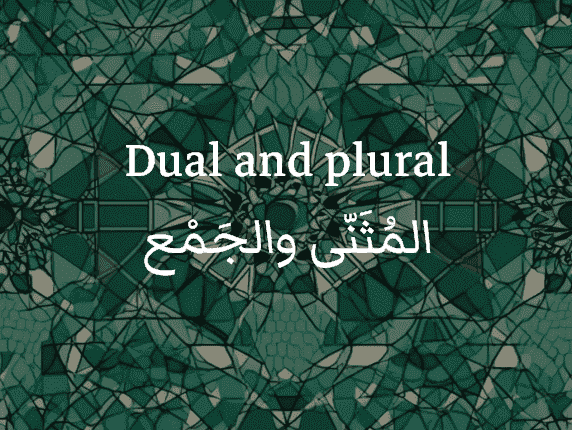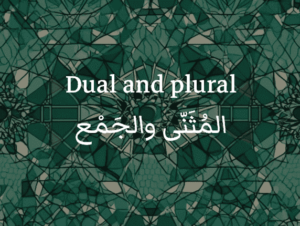Dual and plural / المُثَنّى والجَمْع

Arabic nouns and adjectives are inflected for three numbers:
- Singular / المُفْرَِد
- Dual / المُثَنّى
- Plural / الجَمْع
Dual and plural in Arabic have different specificities which we’ll learn here.
Dual / المُثَنّى
When referring to two items or individuals, the dual is used – between the singular (for one thing/person) and plural (three or more things/people). To form a dual noun in Arabic, simply replace the singular ending with one of these suffixes:
- In the nominative case (مَرْفُوع)
ـانِ… /āni/
- In the accusative (مَنْصوب) and genitive cases (مَجْرور)
ـَيْنِ… /ayni/
| Dual nominative (المُثَنّى المَرْفُوع) | Dual accusative/genitive (المُثَنّى المَنْصُوب/المَجْرور) | Singular (المُفْرَد) |
|---|---|---|
| كِتابانِ two books | كِتابَيْنِ two books | كِتاب a book |
| وَلَدانِ two boys | وَلَدَيْنِ two boys | وَلَد a boy |
Note: The final tā marbūṭa (ة …ـة…) in singular nouns, is replaced by a regular ـتـ /t/ in dual endings:
Dual nominative
(المُثَنّى المَرْفُوع)Dual accusative / genitive
(المُثَنّى المَنْصُوب / المَجْرور)Singular
(المُفْرَد)مَدْرَسَتانِ
two schoolsمَدْرَسَتَيْنِ
two schoolsمَدْرَسَةٌ
a school
Noun modifications
In some cases, when the root of a word is weak or finishes with ي, و or hamza, its ending transforms before adding the dual suffix.
– Words ending with اء:
- ? If the ending اء is the mark of the feminine, the hamza turns into و :
| Dual (المُثَنّى) | Singular (المُفْرَد) |
|---|---|
| صَحْراوانِ two deserts | صَحْراء a desert |
| رِجْلانِ حَمْراوانِ two red legs | رِجْل حَمْراء a red leg |
- ? If the ending in اء is the mark of a weak root, the hamza is maintained or sometimes turns into و:
| Dual (المُثَنّى) | Singular (المُفْرَد) |
|---|---|
| كِساءان two pieces of clothes | كِساء a piece of clothing |
| لِقاءان (not لِقاوانِ) two meetings | لِقاء a meeting |
– If a singular noun ends with a ى, it will become a ي:
| Dual (المُثَنّى) | Singular (المُفْرَد) |
|---|---|
| مُسْتَشْفَيانِ two hospitals | مُسْتَشْفى a hospital |
| صَدَيانِ two echoes | صَدى an echo |
Plural / الجَمْع
There are two types of plural in Arabic:
- The sound plural (الجَمْعُ السالِمُ) which can be compared to the English regular plural.
- The broken plural (جَمْعُ التَكْسِيرِ) which can be compared to the English irregular plural.
The sound masculine plural / جَمْعُ المُذَكّرِ السالِم
To form the sound masculine plural (جَمْعُ المُذَكَّرِ السالِم), we need to replace case endings in the singular form with these two suffixes:
- In the nominative case (مَرْفُوع)
ـونَ… /ūna/
- In the accusative (مَنْصوب) and genitive (مَجْرور) cases
ـِينَ… /īna/
| Plural nominative (الجَمْع المَرْفُوع) | Plural accusative and genitive (الجَمْع المَنْصُوب والمَجْرور) | Singular (المُفْرَد) |
|---|---|---|
| مُهَنْدِسُونَ engineers | مُهَنْدِسِينَ engineers | مُهَنْدِس engineer |
Noun modifications
- For words ending with اء the hamza stays
| Plural (الجَمْع) | Singular (مُفْرَدال) | Noun case (المَحَلّ الإِعْرابي) |
|---|---|---|
بَنّاؤُونَ masons | بَنّاءٌ mason | Nominative case (مَرْفُوع) |
| بَنّائِينَ masons | بَنّاءً / بَنّاءٍ mason | Accusative and genitive cases (مَنْصُوب ومَجْرور) |
- For words ending with ى, the alif disappears but the fatḥa that precedes stays
| Plural (الجَمْع) | Singular (مُفْرَدال) | Noun case (المَحَلّ الإِعْرابي) |
|---|---|---|
مُغَطَّونَ covered | مُغَطًّى (المُغَطَّى) covered | Nominative case (مَرْفُوع) |
| مُغَطَّينَ covered | مُغَطًّى (المُغَطَّى) covered | Accusative and genitive cases (مَنْصُوب ومَجْرور) |
- For active participles of weak verbs, the final kasra and the ي belonging to the root disappear:
| Plural (الجَمْع) | Singular (مُفْرَدال) | Noun case (المَحَلّ الإِعْرابي) |
|---|---|---|
راضُونَ satisfied | راضٍ (الراضِي) satisfied | Nominative case (مَرْفُوع) |
| راضِينَ satisfied | راضٍ (الراضِي) satisfied | Accusative and genitive cases (مَنْصُوب ومَجْرور) |
The sound feminine plural / جَمْعُ المُؤَنّثِ السالِم
To form the sound feminine plural (جَمْعُ المُؤَنَّثِ السالِم), we need to replace case endings in the singular form with these two suffixes (we remove the ة if the word ends like this).
- In the nominative case (مَرْفُوع)
ـاتٌ… /ātun/
- In the accusative (مَنْصوب) and genitive cases (مَجْرور)
ـاتٍ… /ātin/
When the noun is indefinite, the final tanwīn appears.
| Plural | Singular | Noun case (المَحَلّ الإِعْرابي) |
|---|---|---|
| مَلِكاتٌ (المَلِكاتُ) queens | مَلِكةٌ (المَلِكةُ) queen | Nominative case (مَرْفُوع) |
| سِجِلاتٌ (السِجِلاتُ) registers | سِجِلٌّ (السِجِلُّ) register | |
| مَلِكاتٍ (المَلِكاتِ) queens | مَلِكةً (المَلِكةَ )/ مَلِكةٍ (المَلِكةِ) queen | Accusative and genitive cases (مَنْصُوب ومَجْرُور) |
| سِجِلاتٍ (السِجِلاتِ) registers | سِجِلاً (السِجِلَّ) / سِجِلٍّ (السِجِلِّ) register |
Noun modifications
- For nouns ending with ى, اة or اء this ending is replaced by a و or a ي (depending on the root letters):
With اة:
| Plural (الجَمْع) | Singular (المُفْرَد) |
|---|---|
| قَنَوات canals/channels | قَناة canal/channel |
| حَيَوات lives | حَياة life |
With ى:
| Plural (الجَمْع) | Singular (المُفْرَد) |
|---|---|
| عُظْمَيات greatest (feminine) | عُظْمى greatest (feminine) |
| حُبْلَيات pregnant | حُبْلى pregnant |
With اء:
| Plural (الجَمْع) | Singular (المُفْرَد) |
|---|---|
| سَمَاوات skies | سَماء sky |
| صَحْرَاوات deserts | صَحْراء desert |
- For nouns whose singular pattern is فَعْل or فَعْلة and have a 2nd letter that’s neither a ي nor و, the sukūn generally turns into a vowel in the event of a sound plural (the same consonant as the 1st letter being fatḥa):
| Plural (الجَمْع) | Singular (المُفْرَد) |
|---|---|
| سَجَدات prostrations | سَجْدة prostration |
| جَلَسات sessions | جَلْسة session |
| ظُلُمات obscurities | ظُلْمة obscurity |
- Exceptions:
| Plural (الجَمْع) | Singular (المُفْرَد) |
|---|---|
| سَنَوات years | سَنة year |
| شَفَوات lips | شَفة lip |
| بَنات daughters | بِنْت daughter |
| أُمَّهات mothers | أُمّ mother |
| أَخَوات sisters | أُخْت sister |
Note: The sound feminine plural ending typically only applies to human entities.
Broken plurals / جَمْعُ التَكْسِير
The Arabic language comprises a wide array of nouns and adjectives with an irregular plural form referred to as broken plural, or جَمْعُ التَكْسِير. This is analogous to the English equivalent like ‘man – men’, ‘goose – geese’, and ‘tooth– teeth’ or even ‘child-children’.
There are many broken plural patterns. Arabic grammarians have formulated distinctions between small numbers and collective plurals which are neglected today except for certain words such as:
أَحْرُف (less than 10 letters) / حُرُوف (beyond 10 letters) ← (letter) حَرْف
أَشْهُر (less than 12 month) / شُهُور (beyond 12 month) ← (month) شَهْر
Singular words are transformed into broken plural forms through different increments and internal changes. Taking the time to learn these patterns makes it easier to spot plurals within texts, as well as source their singular roots. Unfortunately, there are not any concrete regulations when creating broken plurals from singular words; some may have one or more versions while others could contain both broken and sound varieties. On top of that, it’s essential to note that these irregular formations are used more often than the sound “regular” plural constructions.
Most internal plurals follow the basic three-case declension. A significant number (notably among those of four syllables) are diptotic, some follow the diptotic-defective declination, finally others, few in number, are indeclinable (final in ى)
Triliteral root / الثُلاثي
| Examples (أَمْثِلة) | Plural pattern (الوَزْن) | |
|---|---|---|
| قِطّ ← قِطَط cats ← cat | فِرْقَة ← فِرَق teams ← team | فِعَل |
| مَدِينة ← مُدُن cities ← city | حِمار ← حُمُر donkeys ← donkey | فُعُل |
| صَنَم ← أَصْنام idols ← idol | سُوق ← أَسْواق markets ← market | أَفْعال |
| قارئ ← قُرّاء readers ← reader | طالِب ← طُلاّب students ← student | فُعّال |
| كاتِب ← كَتَبة writers ← writer | طالِب ← طَلَبة students ← student | فَعَلة (variation of فُعّال) |
| طَعام ← أَطْعِمة foods ← food | زَمان ← أَزْمِنة times ← time | أَفْعِلة |
| بَنْك ← بُنُوك banks ← bank | فَنّ ← فُنُون arts ← art | فُعُول |
| سُنّة ← سُنَن traditions ← tradition | صُورة ← صُوَر pictures ← picture | فُعَل |
| ظِلّ ← ظِلال shadows ← shadow | صَغِير ← صِغار small | فِعال |
| حُوت ← حِيتان whales ← whale | جار ← جِيران neighbours ← neighbour | فِعْلان |
| فارِس ← فُرْسان knights ← knight | بِلاد ← بُلْدان countries ← country | فُعْلان |
| شَهْر ← أَشْهُر months ← month | حَرْف ← أَحْرُف letters ← letter | أَفْعُل |
| نَخْل ← نَخِيل palm trees ← palm tree | عَبْد ← عَبيد slaves ← slave | فَعِيل |
| قاعدة ← قَواعِد rules ← rule | قامُوس ← قَوامِيس dictionnaries ← dictionary | فَواعيل / فَواعِل (diptote) |
| قَصِيدة ← قَصائِد poems ← poem | جَزِيرة ← جَزائِر islands ← island | فَعائِل (diptote) |
| أُنْمُلة ← أَنامِل finger tips ← finger tip | أُسْبوع ← أَسابِيع weeks ← week | أَفاعِيل / أفاعِل (diptote) |
| تَجْرِبة ← تَجارِب experiences ← experience | تِمْثال ← تَماثِيل statues ← statue | تَفاعِيل / تَفاعِل (diptote) |
| مِقْدار ← مَقادِير amounts ← amount | مِنْقار ← مَناقِير beaks ← beak | مَفاعِيل (diptote) |
| مَذْهَب ← مَذاهِب doctrines ← doctrine | مَطْعَم ← مَطاعِم restaurants ← restaurant | مَفاعِل (diptote) |
| نَبِيّ ← أَنْبياء prophets ← prophet | صَدِيق ← أَصْدِقاء friends ← friend | أَفْعِلاء (diptote) |
| عالِم ← عُلَماء scholars ← scholar | أَمِير ← أُمَراء princes ← prince | فُعَلاء (diptote) |
| فَتْوى ← فَتاوى advisory opinions ← advisory opinion | سَكْران ← سُكارى drunk | فُعالى / فَعالى (indeclinable) |
| أَحْمَق ← حَمْقى fools ← fool/foolish | مَرِيض ← مَرْضى sick | فَعْلى (indeclinable) |
| مَزيّة ← مَزايا advantages ← advantage | خَطِيئة ← خَطايا sins ← sin | فَعالا (indeclinable) |
Quadriliteral root / الرُباعِي
| Examples (أَمْثِلة) | Plural pattern (الوَزْن) | |
|---|---|---|
| ثَعْلَب ← ثَعالِب foxes ← fox | عُصْفور ← عَصافِير little birds ← little bird | فَعاليل / فَعالِل (diptote) |
| مَغْرِبي ← مَغارِبة Moroccans ← Moroccan | أُسْتاذ ← أَساتِذة professors ← professor | فَعالِلة (diptote) |
Note: Words with 5 roots letters are very rare and originally do not come from the Arabic language. They lose one root letter in the plural form:
بَرْنامَج ← بَرامِج
(programs ← program)
⚠️ Arabic learners are not expected to memorize those patterns, native speakers do not themselves. The aim of this section is to give an overview of the different broken patterns you can find in Arabic. The best practice, after all, is to always memorize both the singular and plural forms when learning a new word. As the student continues to expose himself to the language, most of these occurrences will be memorized organically and almost subconsciously.Now, let’s test your knowledge
Dual and Plural

Learn about the Arabic language's unique dual and plural grammatical structures with our comprehensive guide. Discover the rules, examples, and common pitfalls of using dual and plural in Arabic, and improve your language skills today.
Course Provider: Organization
Course Provider Name: ArabiKey
Course Provider URL: https://arabikey.com
5

Responses